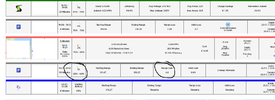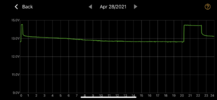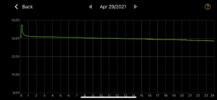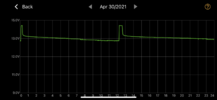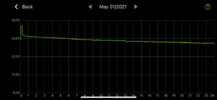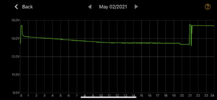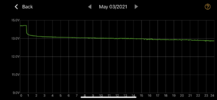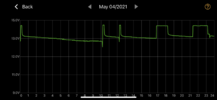Welcome to Tesla Motors Club
Discuss Tesla's Model S, Model 3, Model X, Model Y, Cybertruck, Roadster and More.
Register
Install the app
How to install the app on iOS
You can install our site as a web app on your iOS device by utilizing the Add to Home Screen feature in Safari. Please see this thread for more details on this.
Note: This feature may not be available in some browsers.
-
Want to remove ads? Register an account and login to see fewer ads, and become a Supporting Member to remove almost all ads.
You are using an out of date browser. It may not display this or other websites correctly.
You should upgrade or use an alternative browser.
You should upgrade or use an alternative browser.
Range Loss Over Time, What Can Be Expected, Efficiency, How to Maintain Battery Health
- Thread starter KK_RedM3
- Start date
Candleflame
Active Member
calibration affects only a small proportion of tesla users. mainly those who never let their car sleep or who do lots of shallow discharges from i.e. 40-70%.Well I read the whole thread - gradually, over a period of some weeks. I appreciate all of the input. But I must say, I do not see much consensus about a lot of the underlying issues:
- about real loss of range vs nominal loss of range due to calibration issues
- the degree to which real loss of range is a big issue for many Tesla drivers
it is not really an issue, many people are just pissed off about the early degradation of the model 3 battery compared to the S battery. Cars which are 1 year old and have 20k km on them already have 6-7% degradation.
- the degree to which, if it is a big issue, this is due to a fault on the part of Tesla vs. owners vs. random chance
i think this is by design. im hopeful that it preserves the battery so that we flat out at 10-13% degradation and continue to enjoy high supercharging speed.
- the best ways to minimize real loss of range through battery charging and related strategies
no strategy has been shown to work (apart from perhaps avoid keeping the car at 100% all the time. In all fairness, if you live in Germany and keep your car at 100% all the time, thats probably the same as 90% in northern australia where its hot all the time.
The other thing to avoid is to supercharge from low SOC to 100% repeatedly.
- whether real loss of range can be recovered to any degree.
There are a lot of forum members with strong but differing views on these subjects, but no real agreement.
if it is a calibration issue it can be recovered.
Candleflame
Active Member
you dont really have real range loss. 1% or 2% cant be recalibrated.
Calibration is only needed for cars which never go to sleep and the car cannot get a voltage reading. In my experience the car takes a "hot" voltage reading when put into park after a long drive and a "cold" voltage reading after 3h of sleeping. My car very occasionally seems to take a voltage reading after just 20min - 60min of sleeping ( as evident by i.e. 2% range gain or so when it wakes up).
There is maybe one other instance where cars have been left sitting for ages between 40-70%. I find that evidence annecdotal though and apparently this has been fixed with a software update.
There are countless videos of Bjorn and other tesla wannabewarriors doing deep discharges followed by full recharges to "recalibrate" the pack. This has never ever made any difference.
Good example here of "hot" votlage reading.
I drove to the shopping centre, charged there, got back. Car recovered 5km of range after voltage check while in park before it went to sleep.
It does not happen all the time/consistently.
Interestingly enough it refused to go to sleep - stayed awake for almost an hour. (this may have been due to AC running to dry the filters. I didnt check)
Attachments
Last edited:
'no options enabled'. Does that mean you turned off Summon and Sentry and cabin overheat protection?
random being
Member
That’s correct. I don’t have summon I believe. Sentry and cabin overhear protection are off and there are no third party apps such as TeslaFi running.'no options enabled'. Does that mean you turned off Summon and Sentry and cabin overheat protection?
I just got my 2021 Model 3. It’s currently getting wrapped. Leaving it in the lot alone with no options enabled I’m losing 5 miles a day. Is that normal amount of drain? If not is there anyway to fix it?
TIA
If its draining between 3-6 miles a day that is relatively normal. You can lessen the drain by stopping checking on the car to see how many miles it has lost (dont open the tesla app and check on the car). Every time you do that, you wake the car up, increasing how much energy it will use for that day, since it has to take a bit of time (and energy) to both wake up, then go back to sleep.
It also wont sleep while they have the doors open working on it at your wrap place but you might know that already.
If the app is running but not in the foreground, does that keep the car awake? Just curious. And a related question, does Android/Apple change that answer.(dont open the tesla app and check on the car).
If the app is running but not in the foreground, does that keep the car awake? Just curious. And a related question, does Android/Apple change that answer.
I dont think so but havent tested it a lot either. I use iOS. Apps in iOS get backgrounded unless you swipe them away. If you open the tesla app when the app is backgrounded, you normally see "waking up" if the vehicle is selected, so by deduction it appears that backgrounding the app allows it to go to sleep. You cant see how many miles the car has left on it until it wakes up, though.
You can also use a widget to see the car is sleeping on iOS , and fairly sure on android (since android invented the idea of widgets on the modern smartphone, apple just likes to pretend they did).
In any case, "5 miles a day" is almost nothing, and certainly nothing to "fix" but its probably causing the person asking the question 1-2 miles a day in waking the car up "checking" it.
random being
Member
If its draining between 3-6 miles a day that is relatively normal. You can lessen the drain by stopping checking on the car to see how many miles it has lost (dont open the tesla app and check on the car). Every time you do that, you wake the car up, increasing how much energy it will use for that day, since it has to take a bit of time (and energy) to both wake up, then go back to sleep.
It also wont sleep while they have the doors open working on it at your wrap place but you might know that already.
For 24 hours exactly I didn’t check the Tesla app so that would not effect the results.
For 24 hours exactly I didn’t check the Tesla app so that would not effect the results.
Ok. There still is nothing "wrong" with 5 mile a day figure, nor is there much if anything you can do to get it lower. Sentry mode, cabin overheat, etc would all pull more power than that.
random being
Member
Thanks for your helpOk. There still is nothing "wrong" with 5 mile a day figure, nor is there much if anything you can do to get it lower. Sentry mode, cabin overheat, etc would all pull more power than that.
if you are talking about "from sitting and not driving" any capacity locked out because the battery is cold would be returned when the battery warmed up. If you are talking about "while driving" I am not getting into that at all.What I am gathering....
Cold weather (sub 0F) drops battery up to 50%
Daily drain 1-2%
Me on day five into a cold spell when i havent touched the car means I have maybe 40% before even heating the vehicle?
5 miles in 24 hrs is 0.2miles/hr. That's pretty close to the median, according to Stats:I just got my 2021 Model 3. It’s currently getting wrapped. Leaving it in the lot alone with no options enabled I’m losing 5 miles a day. Is that normal amount of drain? If not is there anyway to fix it?
TIA
AlanSubie4Life
Efficiency Obsessed Member
Thanks for your help
If there is any disturbance of the car (like opening a door), it may turn on the climate control, which can drain the battery rapidly. Unless you are 100% certain that nobody opened the door, etc., during this 24-hour period, the data is a bit suspect.
Another issue is that during the first period after being driven, and when the car goes to sleep, it may rebalance or reassess the state of charge, and adjust the range accordingly (by a few miles). The second and third days, etc., this is less of an issue. So I'd ignore the first day of data.
The optimal time to log your vampire drain is when you leave the car for 4-5 days or more in a garage - not when you're getting it wrapped or when the car is in for service. Check it after one day, use that as your starting point, and then log the results upon your return, without checking the car in the meantime.
In a typical scenario where the car is completely left alone for days, with all of the known drains turned off (Summon Standby, Sentry, Cabin overheat protection, third-party apps, etc.), the car will be idle for a couple hours and sleep the rest of the time. (If you want to understand this cycling, get a 12V battery monitor, though it's more of a novelty than anything else, because you'll understand how it works after a couple weeks.) Anyway, this results in about 500Wh of drain, or around 2 rated miles a day. Sometimes a bit more, sometimes a bit less. It's a very rough number, but we know that idle mode uses around 150-200W, and sleep mode is closer to 10W (again, very rough numbers, probably +/-30%). The rest is math. The idle mode level may depend on temperature a bit, too - it's not clear when the windshield camera heater element actually enables (does it depend on temperature?), and whether the side repeater cameras are heated (they do have heat signatures in an IR camera when the car is in idle mode, but it may just be them being turned on).
If you're bothered by the drain of your car when it's sitting, be sure to turn off climate control manually when you exit - (warning: this will result in a moldy smell eventually, probably, since the automatic fan to dry out the cabin air filter can't operate), but it means that when people open the doors, etc., it won't be draining energy rapidly. You can lose a lot of energy just by getting something out of your car, washing it, cleaning it, etc., when climate control is left on, especially in the winter (perhaps less of an issue for a 2021 but still an issue).
5 miles in 24 hrs is 0.2miles/hr. That's pretty close to the median, according to Stats:
One thing that bothers me about Stats is that as far as I can tell it doesn't log negative vampire drain. This does happen (due to rebalancing or whatever), and it's misleading if you don't count the (usually rare) negative numbers. In addition: it would be nice if it would detect the car mode (Sentry, etc. - I think it has access to most of the information about whether Sentry is on, whether climate is on, etc.) and categorize those drains separately, as well. I'd like to see two categories: vampire drain (only logged in low-drain scenarios where none of the features enabled), and a separate plot for "vampire+feature drain" results. I suspect both the average and the long tail of this distribution are heavily influenced by feature drain.
Yeah, the developer, for whatever reason, doesn't seem interested in analyzing or thinking about the data he's showing and whether he can make it more informative. It only took him 2 years to change the SOC api he was using to take out the temperature effects, after I'd complained to him multiple times.One thing that bothers me about Stats is that as far as I can tell it doesn't log negative vampire drain. This does happen (due to rebalancing or whatever), and it's misleading if you don't count the (usually rare) negative numbers. In addition: it would be nice if it would detect the car mode (Sentry, etc. - I think it has access to most of the information about whether Sentry is on, whether climate is on, etc.) and categorize those drains separately, as well. I'd like to see two categories: vampire drain (only logged in low-drain scenarios where none of the features enabled), and a separate plot for "vampire+feature drain" results. I suspect both the average and the long tail of this distribution are heavily influenced by feature drain.
AlanSubie4Life
Efficiency Obsessed Member
I guess this topic qualifies as on topic as "range loss over time," lol.I just got my 2021 Model 3. It’s currently getting wrapped. Leaving it in the lot alone with no options enabled I’m losing 5 miles a day. Is that normal amount of drain? If not is there anyway to fix it?
TIA
As an addendum here's some data from a 12V logger. I was away for the first week or so, and you can see very minimal (average less than 2 hours per day) of idle mode. I didn't track it precisely in this case, but my guess is about 1-2 miles a day of range loss. But once I got back in town on evening of May 2nd, you can see the pulsing on and off of the 12V charger, due to proximity to vehicle, opening doors, driving, etc. Physically I spent very little time with the vehicle, but just being in proximity and doing things with it disrupts its sleep schedule (which is typically determined by when the 12V battery needs to be topped off due to the constant ~10W drain).
So, again, checking vampire drain while dropping the car off for service or work, is just not representative.
Sample, out of town (just a half hour of idle mode):
Attachments
Your advice please.
I have driven from Columbus Ohio to both Seattle WA and another trip to Memphis. Never has any leg of the planned trip been over 160 miles. But on a new plan including a leg of the trip being 225 miles i am nervous about driving to Houston in very hot weather temperatures, possibly up to 90 degrees F.
1. I usually configure my car to a max charge of 90% which yields 250 miles. Is that low for a 90%?
2. If i charge to the max 100% and immediately take off what would that charge be in miles on a 2020 Model 3. Does that degrade the battery performance in the long run?
Can i make it 225 miles?
I have driven from Columbus Ohio to both Seattle WA and another trip to Memphis. Never has any leg of the planned trip been over 160 miles. But on a new plan including a leg of the trip being 225 miles i am nervous about driving to Houston in very hot weather temperatures, possibly up to 90 degrees F.
1. I usually configure my car to a max charge of 90% which yields 250 miles. Is that low for a 90%?
2. If i charge to the max 100% and immediately take off what would that charge be in miles on a 2020 Model 3. Does that degrade the battery performance in the long run?
Can i make it 225 miles?
Similar threads
- Replies
- 43
- Views
- 3K
- Replies
- 1
- Views
- 134
- Replies
- 10
- Views
- 522
- Replies
- 13
- Views
- 601
- Replies
- 3
- Views
- 186



